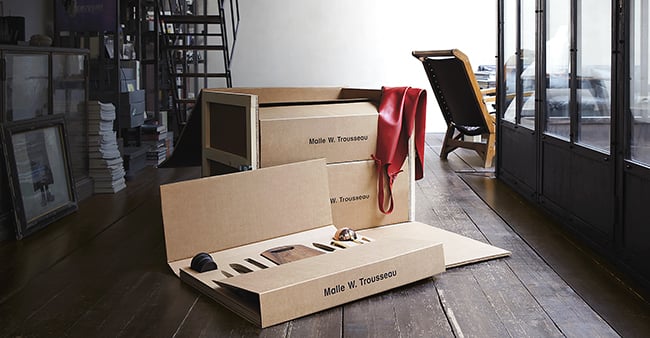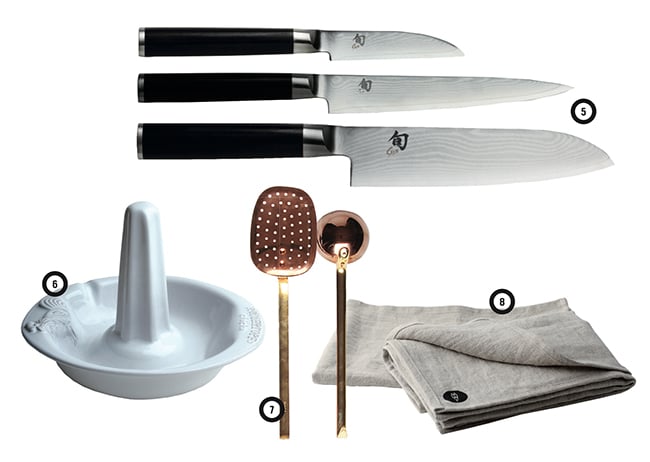
September 9, 2013
Legacy Kitchen: Culinary Tools You Can Pass Down
The Malle W. Trousseau collects culinary tools you’d be proud to hand down.

Photos: Marie Pierre Morel and Ian Scigliuzzi/courtesy MoMA Design Store
Time and again, our itinerant lives require a molting process. When leaving home, changing jobs, and chasing our dreams, we are forced to shed our possessions in a series of yard sales and Craigslist ads. The objects we desperately cling to—the cooking pot, the paintings, the dinnerware set with a chipped plate—are the ones that carry our ideas of home in them. So when the French entrepreneur Isabelle Mathez’s 18-year-old daughter decided to move out, the soon-to-be empty nester discovered that she might end up with a bare kitchen as well. Her daughter wanted to take a treasured chopping board made by a friend of the family, a cast-iron casserole designed by Timo Sarpaneva in 1959, and a Corsican knife, among other things. “She wanted to carry with her the rituals that have been in her life since she was a child,” Mathez says.
That’s how Mathez ended up creating the Malle W. Trousseau, a set of 43 handpicked and custom-made tools to help modern nomads set up a world-class kitchen no matter where they go. Out of the objects she had collected over a lifetime for her two homes in Paris and the Alps, as well as the items she had noticed on her travels, Mathez and her business partner, Juliette Thevenin, packed a beautiful wood-and-cardboard trunk in three layers—containers, cooking utensils, and cutting tools.

1 Timo Sarpaneva’s 1959 Cast Iron Casserole is a Scandinavian icon. “It’s so nice, you can bring it directly to the table,” Mathez says.
2 This leather apron “was made by a saddler in the Alps. He usually makes bridles for horses and collars for cows.”
3 “Most chopping boards are glued, and I hate the idea of having glue in contact with food.” This walnut chopping board is carved from a single piece of wood.
4 Manufactured by Mauviel,“an old company supplying very famous chefs’ restaurants in France since the 1830s,” this sturdy frying pan is “indispensable. You only need one, in a large size, for a lifetime.”
The Malle represents a very personal view of the kitchen— a place where both artistry and robust work have their place. The peelers, for instance, come in three varieties: one for hardy vegetables like potatoes and carrots, another for the thin sheaths of tomatoes and kiwis, and the last one to make delicate vegetable noodles. The dramatic red apron, on the other hand, is not made from cloth, but out of leather. “It was inspired by a blacksmith’s apron,” Mathez says. “I feel very protected in it, it’s like a second skin.”

5 “I found these Shun knives in Tokyo two years ago. I also found out that one of the biggest chefs in France, Michel Bras, makes his knives with the same company that makes these.”
6 This chicken cooker “is a very strange object,” Mathez says. “It comes from Germany, and it makes a perfect roasted chicken.”
7 This skimmer and ladle are made by Mauviel. “The copper is a throw-back to the traditional French way of cooking.”
8 “You always need several dishcloths in a kitchen,” Mathez says. “These are a mix of hemp and linen. Hemp is a very strong and absorbent material, stronger than cotton or linen.”
It was this mix that caught the eye of Emmanuel Plat, the director of merchandising at the retail division of New York’s Museum of Modern Art, where the Malle W. Trousseau will be sold exclusively in the U.S. this fall. “It was a blend of design classics, humble masterpieces of design, and very practical and basic products,” he says, an approach that echoes the museum’s own curatorial approach. For those of us who might balk at the $5,800 price tag, some pieces in the set—like the Sarpaneva casserole—are available at the store, while Mathez is offering six other hard-to-find items online. But Plat tends to view the Malle as an investment, in both financial and emotional terms. “These objects are timeless,” he says. “They’re not going to go out of style. They can withstand the passage of time, stay with you through your life, and be passed on to another generation.”

9 These three vegetable peelers, each with a specific function, are also sold as a separate collection. “They come from a Swiss company that has been making them since 1947,” she says. “It’s a classic example of good design. I once spoke to a lady who used them for thirty years.”
10 Professional cooks in France use this 8-liter aluminum colander. “It’s light, stable, and large enough. I always find other colanders too small.”





